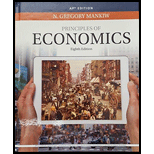
The consumer surplus and the producer surplus .
Answer to Problem 1CQQ
Option 'a' is correct.
Explanation of Solution
The
The maximum willing to pay price by the consumer for the massage here is $300. The actual price that the consumer pays after the negotiation between the two is $200. Since the difference between the maximum willing to pay price and the actually paying price is the consumer surplus, it can be calculated as follows:
Thus, the consumer surplus is $100.
Similarly, the minimum willing to accept price by the massager is $60 per hour and she spends 2 hours for the service, which totally costs $120, minimum. But the actual amount received by her is $200; this difference between the actual price received by the seller and the minimum willing to accept price is the producer surplus, which can be calculated as follows:
Thus, the producer surplus is $80.
Option (a):
Here, the consumer surplus is $100 from receiving the massage from the producer and the producer surplus is $80 by providing the massage service to the consumer. The difference between the consumer surplus and the producer surplus is $20. This means that the consumer surplus is higher than the producer surplus by $20 and hence, option 'a' is correct.
Option (b):
Here, the consumer surplus is $100 from receiving the massage from the consumer and the producer surplus is $80 by providing the massage service to the consumer. This means that the consumer surplus is higher than the producer surplus by only $20. But the given value in option 'b' is $40, which is twice the actual value. Thus, option 'b' is incorrect.
Option (c):
The consumer surplus is $100 from receiving the massage from the consumer and the producer surplus is $80 by providing the massage service to the consumer. This means that the consumer surplus is higher than the producer surplus by $20. Option 'c' points that the producer surplus is higher than the consumer surplus by the value of $20, which is inverse to the actual situation. Thus, option 'c' is incorrect.
Option (d):
The consumer surplus is $100 from receiving the massage from the producer and the producer surplus is $80 by providing the massage service to the consumer. The difference between the consumer surplus and the producer surplus is $20. The consumer surplus is $20 more than the producer surplus. Since option 'd' argues that the producer surplus is $40 larger than the consumer surplus, option 'd' is incorrect.
Concept introduction:
Consumer surplus: It is the difference between the highest willing to pay
Producer surplus: It is the difference between the lowest willing to accept price by the producer and the actual price that is received by the producer.
Equilibrium price: It is the market price determined by equating the supply to the demand. At this equilibrium point, the supply will be equal to the demand and there will be no excess demand or
Want to see more full solutions like this?
Chapter 7 Solutions
Principles Of Economics, Ap Edition, 9781337292603, 1337292605, 2018
- How Command Economics Relate to Principle Of Economics?arrow_forwardhow commond economies relate to principle Of Economics ?arrow_forwardCritically analyse the five (5) characteristics of Ubuntu and provide examples of how they apply to the National Health Insurance (NHI) in South Africa.arrow_forward
- Critically analyse the five (5) characteristics of Ubuntu and provide examples of how they apply to the National Health Insurance (NHI) in South Africa.arrow_forwardOutline the nine (9) consumer rights as specified in the Consumer Rights Act in South Africa.arrow_forwardIn what ways could you show the attractiveness of Philippines in the form of videos/campaigns to foreign investors? Cite 10 examples.arrow_forward
- Explain the following terms and provide an example for each term: • Corruption • Fraud • Briberyarrow_forwardIn what ways could you show the attractiveness of a country in the form of videos/campaigns?arrow_forwardWith the VBS scenario in mind, debate with your own words the view that stakeholders are the primary reason why business ethics must be implemented.arrow_forward
- The unethical decisions taken by the VBS management affected the lives of many of their clients who trusted their business and services You are appointed as an ethics officer at Tyme Bank. Advise the management regarding the role of legislation in South Africa in providing the legal framework for business operations.arrow_forwardTyme Bank is a developing bank in South Africa and could potentially encounter challenges similar to those faced by VBS in the future. Explain five (5) benefits of applying business ethics at Tyme Bank to prevent similar ethical scandals.arrow_forward1.3. Explain the five (5) ethical challenges that can be associated with the implementation of the National Health Insurance (NHI) in South Africa.arrow_forward
 Essentials of Economics (MindTap Course List)EconomicsISBN:9781337091992Author:N. Gregory MankiwPublisher:Cengage Learning
Essentials of Economics (MindTap Course List)EconomicsISBN:9781337091992Author:N. Gregory MankiwPublisher:Cengage Learning


 Economics (MindTap Course List)EconomicsISBN:9781337617383Author:Roger A. ArnoldPublisher:Cengage Learning
Economics (MindTap Course List)EconomicsISBN:9781337617383Author:Roger A. ArnoldPublisher:Cengage Learning





